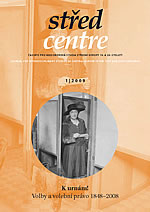Bílé lístky
White Ballots
Author(s): Michal PehrSubject(s): History
Published by: AV ČR - Akademie věd České republiky - Masarykův ústav
Keywords: Czechoslovakia 1945–1948; elections; political history
Summary/Abstract: The end of the World War II and the reinstallation of Czechoslovakia brought many changes, which influenced the development of suffrage. In general, these changes resulted in more or less restrictions of suffrage (apart from lowering the age limit for acquiring active and passive suffrage). One of such important changes were so called white ballots, this study deals with. White ballots were used only during the 1946 and 1948 elections. By casting such a white ballot, voters had the opportunity to vote for nobody and nothing. Their introduction was interpreted as a possibility to protest legally, freely and democratically against the new situation in the state. In reality, however, their introduction meant a restriction of suffrage, with the main political agents of the Third Czechoslovak Republic trying to estimate, how many inhabitants did not agree with the new political setting. White ballots played even a more important role during the 1948 elections, which were perceived as a confirmation of the communist February takeover. The voters had the opportunity to vote either for a singular ballot of the popular front or to cast a white ballot. A strong campaigning against the opportunity to cast a white ballot was launched by the communist and was accompanied with psychological and occasionally even physical intimidation. Despite of this, approximately 10 per cent of the population took advantage of the opportunity and did cast a white ballot. It was the single opportunity to present personal opinions at the beginning of the communist totalitarian regime.
Journal: Střed. Časopis pro mezioborová studia Střední Evropy 19. a 20. století
- Issue Year: 1/2009
- Issue No: 1
- Page Range: 95-109
- Page Count: 15
- Language: Czech

